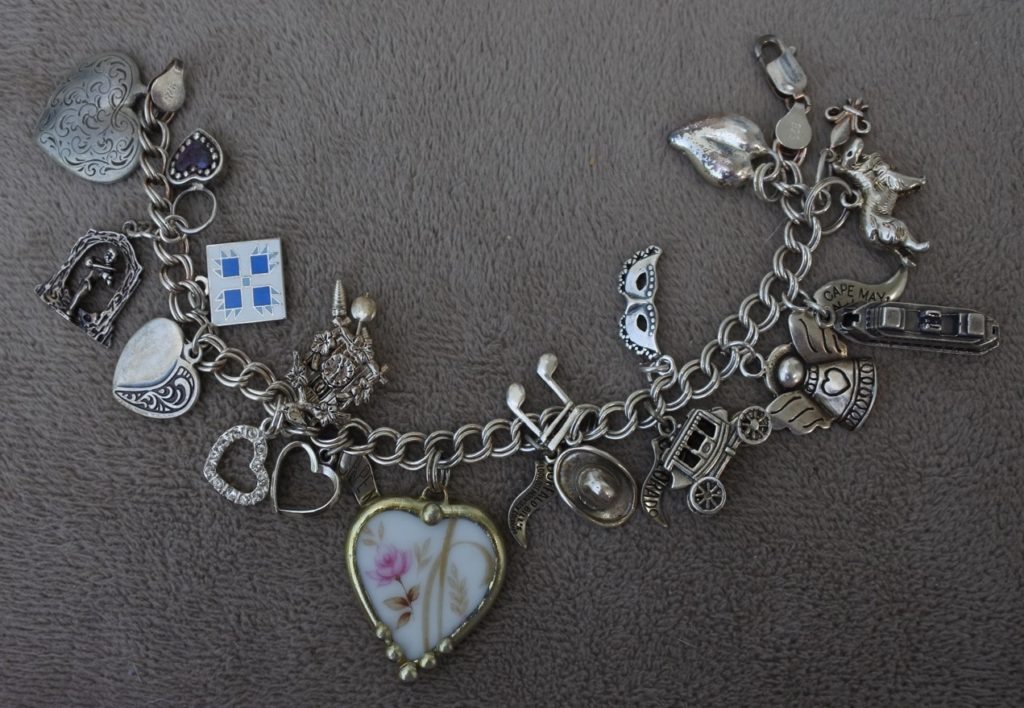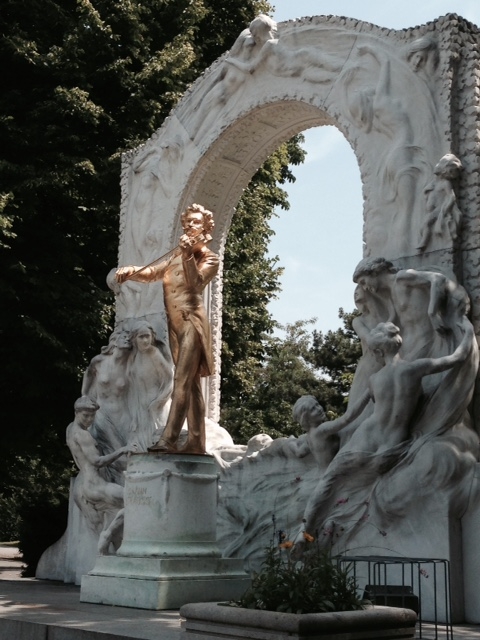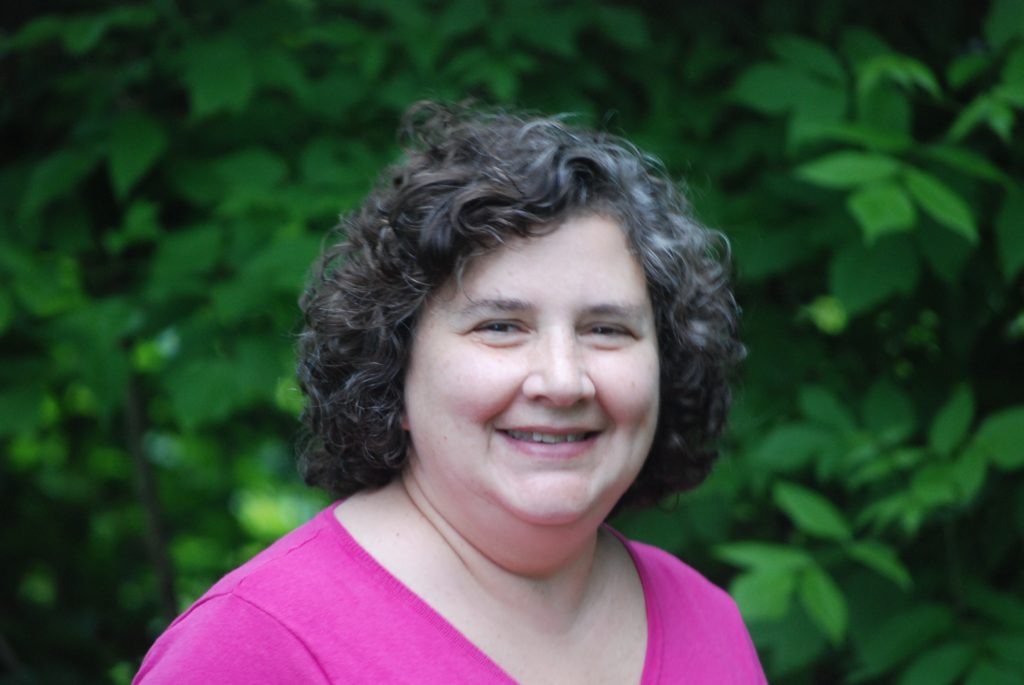A Visual Model for Writing
When I read an essay or listen to a presentation, I’m always fascinated by how the writer or speaker organizes and presents their content. Did the content drive the form, or did they fit the content into a desired form? A friend of mine explained to me that he wanted to use a visual model to illustrate the content of his Ph.D. dissertation. He chose a tiered wedding cake to show how the information he was presenting got more focused (and smaller) as he went along. He started at the biggest tier and ate his way up to the smallest, most esoteric and focused, tier at the top. I was writing a craft essay about travel writing for my MFA degree at the time of this conversation, and I wanted a model, too. But what?
I brainstorm in the morning as I drive to work, and one day, soon after my conversation with Dr. Wedding Cake, I happened to look at my wrist. My eyes were still on the road, but my wrist was also right there in front of me. There was my charm bracelet, but suddenly it was not a charm bracelet, but a model for travel writing. I used it, suffered many puns about how charming my craft essay was, but most importantly I graduated. It was charming.

I wrote an essay about Johann Strauss II, the “Waltz King.” I had been to his hometown, Vienna, twice in 2015, once with my sister as part of a river cruise, and again with my MFA cohort. On the bus back to our ship after a concert, an arrogant young man seated behind my sister and me went on and on about how the music we heard that evening (short pieces by Vienna’s two favorite sons, Strauss and Mozart), was not really “classical” music. It was too short. He attends Cleveland Orchestra concerts where the music sometimes stretches out to forty minutes, and . . . they play Disney music! This guy, his arrogance and absurd ideas about serious art music, formed a strand of the bracelet. Wound together with his observations was the researched information about Johann Strauss II, his father, and his brothers, all of whom were composers and conductors. I presented this information as if in response to the arrogant guy’s bus screed. (“So there!” I was saying, but with researched facts.) The bracelet is the through line of the piece. Since I brought the arrogant bus guy back at the end of the essay, I had connected the ends of my essay, or, if you picture the model, clasped the bracelet.

Johann Strauss 
Strauss house, Vienna
In order to make the story more compelling, unique, and personalized, I added “charms.” Experiences do not usually unfold in a straightforward, chronological way. There are distractions, delays, epiphanies, chance meetings, and coincidences. These, in my model, would be the charms. Typically for my writing, I group these into four categories: Memoir, Research, Anecdote, and Culture. Charms of memoir add personalization to the narrative. Recounting what I’m thinking of as I travel to a place or sharing lessons I’ve learned would count as memoir. Some writers add a lot of memoir, and some only a little bit. Conversations (including eavesdropped conversations, as on the Vienna bus), stories and diversions, souvenir acquisition, descriptions of people all qualify as Anecdote Charms. Recurring themes (the Gaelic folktales of Ireland), museum visits (the Johann Strauss Museum), and the art, literature, and music of a place constitute Culture Charms. Culture Charms give the reader a sense of place. Research Charms can stand alone or support other charms. I frequently dive into the music or literature of a place and research it before and after the trip. The before-research sometimes guides me in a place: I knew I wanted to know about Franz Kafka before I went to Prague, for example. The after-research is, of course, informed by what I’ve seen and experienced, such as with the Strauss Family research in my Waltz King essay. The writer should experiment with the best placement of these charms on the bracelet/through line. Experiment. As with an actual charm bracelet, some charms will dominate and some will be more subtle.
I listed my possible Vienna charms as I brainstormed the Waltz King essay:
- Getting lost and frustrated trying to find the Johann Strauss Museum, which at that time had only a small sign barely visible from the street and no clues about walking halfway to the courtyard, entering an unmarked door, and walking up a flight of steps to find the museum once I found the address. MEMOIR
- Exploring the museum and gazing in wonderment at Johann Strauss II’s piano encased in a glass box, a lock of his first wife’s hair, and, worthy of its own charm on the bracelet, the creepy Johann Strauss II death mask. These plaster records of famous dead people’s faces were a thing then. CULTURE
- Finding the famous gold statue of Johann Strauss II playing his violin among the other composer statues in Vienna’s Stadtpark, near the Kursalon where Strauss and his orchestra performed. ANECDOTE
- Looking at the painting of Johann Strauss II in the hotel lobby in which his moustache is wider than his face. CULTURE (ART)
- Listening to (or desperately tuning out) the Strauss music on a continuous loop in the Johann Strauss Hotel’s breakfast room day after day, until it became absurd and distorted in my head. ANECDOTE
- Listening to the Strauss music on the Austria Air flight as we prepared for takeoff: a last laugh from Vienna. ANECDOTE
- Reading about the Strauss family, their scandals, careers, and music, and deciphering the best bits for the essay. RESEARCH (This turned out to be vitally important–it became part of the bracelet or through line.)
These were the charms I chose from for my essay. I had to decide which of these would support the idea, and that became the theme of my essay: a defense of Johann Strauss, who truly was an innovative composer and is still loved by the people of Vienna. Some charms would be central (the biographical information), and some would be quick diversions (the overplayed music, the statue in the park), and some might be scrapped altogether. If you would like to read the finished essay, I invite you to visit it at Clever Magazine.
And one more thing: As I worked with this model while writing and helping others write travel stories, I came upon another element to add to the charm bracelet: the Filigree. This could be a quote, a few lines of a poem, or some other little nugget used to simply decorate a larger section.
I thought that the charm bracelet model would be just a gimmick to give my craft essay some bling, but to my surprise, that model has hung on in my mind and I visualize it whenever I write a travel essay now. It works! Have you ever used a visual model for your writing?
About the Author: Margaret Montet
Margaret Montet’s narratives of place are combined with memoir, research, and culture. She’s a college librarian and professor who recently earned her MFA in Creative Writing from the Pan-European Program at Cedar Crest College. Her creative nonfiction has been published in The Bangalore Review, Clever Magazine, Dragon Poet Review, Pink Pangea, Flying South, and other fine periodicals. Visit her website at www.MargaretMontet.com.

1 Comment
JEK Proofreading & Editing · July 13, 2021 at 7:10 pm
[…] I recently had the opportunity to interview friend and fellow writer Margaret Montet about her forthcoming book, Nerd Traveler. While Margaret has had many essays and articles published through the years, this is her first full-length book. The publishing industry can be tricky to navigate, so I was interested in Margaret’s experience and what tips and suggestions she might have for writers–especially for writers of nonfiction. I am sharing her answers here and hope that you’ll find them helpful! (Margaret was also a guest blogger on my site back in 2019; you can read that post here.) […]